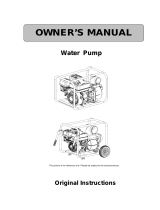
WATER PUMP OPERATOR’S MANUAL
GETTING STARTED
CONNECTING WATER INLET HOSE
Always use a quality inlet hose with reinforced construction to prevent hose collapse, the hose must be a
continuous hose with no joins or kinks and should be fully unrolled. NOTE: Suction and priming times will
vary depending on the length of the inlet hose and the height of the pump from the water source
Prior to priming the pump, ALWAYS ensure the pre-filter is connected to the end of the water inlet hose.
The filter will catch large particles that may jam and damage the pump impellers. Be sure to install hose
clamps tightly to prevent air leaks which will reduce the pumps performance.
CONNECTING WATER OUTLET HOSE
Always use a quality outlet hose designed to be used with the same outlet size of the pump. Runnings
and smaller diameter hose that the outlet of the pump will increase flow resistance and decrease the
power output and flow rate of your pump.
Note: Securely tighten the hose clamps to ensure the hose does not blow off when under pressure.
ENGINE OIL LEVEL CHECK
Using quality engine oil is key to the ongoing
performance of your engine, always use the
specified oil for your Engine.
SAE 10W-30 is recommended for general use.
Other viscosities shown in the chart may be
used when the average temperature in your
area is within the recommended range.
Engine oil capacity: 600ml
NOTE: The engine has a low oil sensor which prevents the engine from running with not enough oil in
the crankcase. The oil alert system will automatically stop the engine before the oil level falls below the
safe limit. However, to avoid the inconvenience of an unexpected shutdown, always check the engine oil
level before start-up.
22
damage.
4. Screw in the oil filler cap/dipstick securely.
ENGINE OIL RECOMMENDATIONS
Oil is a major factor affecting performance and service life. Use 4-stroke
automotive detergent oil.
SAE 10W-30 is recommended for general use. Other viscosities shown in the
chart may be used when the average temperature in your area is within the
recommended range.
SAE Viscosity Grades
AMBIENT TEMPERATURE
The SAE oil viscosity and service classification are in the API label on the oil
container. We recommend that you use API SERVICE category SJ oil.
The recommended operating range of this pump is 23 °F to 104 °F ( -5 °C to
40 °C).
AIR FILTER CLEANING
A dirty air filter will restrict air flow to the carburetor, reducing engine performance.
If you operate the pump in very dusty areas, clean the air filter more frequently
than specified in the MAINTENANCE SCHEDULE (see page 17).
1. Clean the air filter in warm soapy water, rinse, and dry it thoroughly. Or clean
OIL FILLER
CAP/DIPSTICK
DRAIN PLUG & SEALING WASHER
OIL LEVEL
8
Check Engine Oil Level
Check the engine oil level with the engine stopped and in a level position.
1. Remove the oil filler cap/dipstick and wipe it clean.
2. Insert and remove the dipstick without screwing it into the filler neck. Check the oil
level shown on the dipstick.
3. If the oil level is low, fill to the edge of the oil filler hole with the recommended oil (see
page 19).
4. Screw in the oil filler cap/dipstick securely.
Running the engine with a low oil level can cause engine damage.
Engine oil capacities:
DS20-1、DS30: 0.6L DS40:1L
Air Filter Inspection
A dirty air filter will restrict air flow to the carburetor, reducing engine and pump
performance.
Remove the air cleaner cover and inspect the filter. Clean or replace dirty filter elements.
Always replace damaged filter elements. If equipped with an oil-bath air cleaner, also check
the oil level.
Reinstall the air filter and air cleaner cover. Be sure all the parts shown below are in place.
Tighten the wing nut securely.
OIL FILLER CAP/DIPSTICK
OIL FILLER NECK
8
Check Engine Oil Level
Check the engine oil level with the engine stopped and in a level position.
1. Remove the oil filler cap/dipstick and wipe it clean.
2. Insert and remove the dipstick without screwing it into the filler neck. Check the oil
level shown on the dipstick.
3. If the oil level is low, fill to the edge of the oil filler hole with the recommended oil (see
page 19).
4. Screw in the oil filler cap/dipstick securely.
Running the engine with a low oil level can cause engine damage.
Engine oil capacities:
DS20-1、DS30: 0.6L DS40:1L
Air Filter Inspection
A dirty air filter will restrict air flow to the carburetor, reducing engine and pump
performance.
Remove the air cleaner cover and inspect the filter. Clean or replace dirty filter elements.
Always replace damaged filter elements. If equipped with an oil-bath air cleaner, also check
the oil level.
Reinstall the air filter and air cleaner cover. Be sure all the parts shown below are in place.
Tighten the wing nut securely.
OIL FILLER CAP/DIPSTICK
OIL FILLER NECK
UPPER LIMIT
LOWER LIMIT
FUEL LEVEL CHECK
The engine is certified to operate on
unleaded fuel with a research octane
rating of 91 or higher (a pump octane
rating of 86 or higher). You may use
unleased fuel containing no more
than 10% ethanol (E10).
Always check the fuel level prior to
starting the engine. With the engine
stopped and on a level surface,
remove the fuel cap and check the
fuel level and refill if too low. Fill to
the maximum level of the fuel tank.
DO NOT overfill.
5
www.itmtools.com.au














